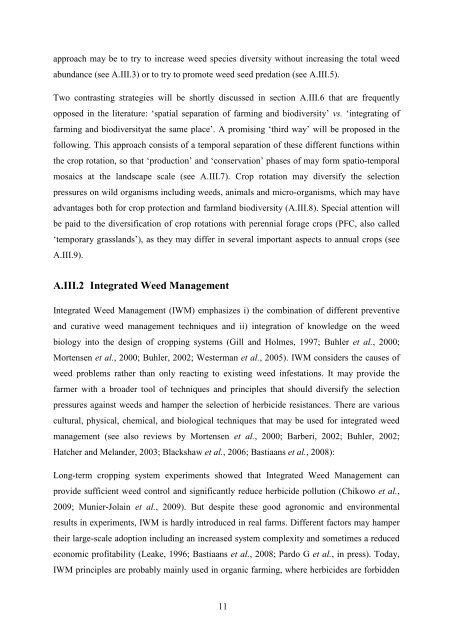Diversifying crop rotations with temporary grasslands - Université de ...
Diversifying crop rotations with temporary grasslands - Université de ...
Diversifying crop rotations with temporary grasslands - Université de ...
Create successful ePaper yourself
Turn your PDF publications into a flip-book with our unique Google optimized e-Paper software.
approach may be to try to increase weed species diversity <strong>with</strong>out increasing the total weed<br />
abundance (see A.III.3) or to try to promote weed seed predation (see A.III.5).<br />
Two contrasting strategies will be shortly discussed in section A.III.6 that are frequently<br />
opposed in the literature: ‘spatial separation of farming and biodiversity’ vs. ‘integrating of<br />
farming and biodiversityat the same place’. A promising ‘third way’ will be proposed in the<br />
following. This approach consists of a temporal separation of these different functions <strong>with</strong>in<br />
the <strong>crop</strong> rotation, so that ‘production’ and ‘conservation’ phases of may form spatio-temporal<br />
mosaics at the landscape scale (see A.III.7). Crop rotation may diversify the selection<br />
pressures on wild organisms including weeds, animals and micro-organisms, which may have<br />
advantages both for <strong>crop</strong> protection and farmland biodiversity (A.III.8). Special attention will<br />
be paid to the diversification of <strong>crop</strong> <strong>rotations</strong> <strong>with</strong> perennial forage <strong>crop</strong>s (PFC, also called<br />
‘<strong>temporary</strong> <strong>grasslands</strong>’), as they may differ in several important aspects to annual <strong>crop</strong>s (see<br />
A.III.9).<br />
A.III.2 Integrated Weed Management<br />
Integrated Weed Management (IWM) emphasizes i) the combination of different preventive<br />
and curative weed management techniques and ii) integration of knowledge on the weed<br />
biology into the <strong>de</strong>sign of <strong>crop</strong>ping systems (Gill and Holmes, 1997; Buhler et al., 2000;<br />
Mortensen et al., 2000; Buhler, 2002; Westerman et al., 2005). IWM consi<strong>de</strong>rs the causes of<br />
weed problems rather than only reacting to existing weed infestations. It may provi<strong>de</strong> the<br />
farmer <strong>with</strong> a broa<strong>de</strong>r tool of techniques and principles that should diversify the selection<br />
pressures against weeds and hamper the selection of herbici<strong>de</strong> resistances. There are various<br />
cultural, physical, chemical, and biological techniques that may be used for integrated weed<br />
management (see also reviews by Mortensen et al., 2000; Barberi, 2002; Buhler, 2002;<br />
Hatcher and Melan<strong>de</strong>r, 2003; Blackshaw et al., 2006; Bastiaans et al., 2008):<br />
Long-term <strong>crop</strong>ping system experiments showed that Integrated Weed Management can<br />
provi<strong>de</strong> sufficient weed control and significantly reduce herbici<strong>de</strong> pollution (Chikowo et al.,<br />
2009; Munier-Jolain et al., 2009). But <strong>de</strong>spite these good agronomic and environmental<br />
results in experiments, IWM is hardly introduced in real farms. Different factors may hamper<br />
their large-scale adoption including an increased system complexity and sometimes a reduced<br />
economic profitability (Leake, 1996; Bastiaans et al., 2008; Pardo G et al., in press). Today,<br />
IWM principles are probably mainly used in organic farming, where herbici<strong>de</strong>s are forbid<strong>de</strong>n<br />
11

















